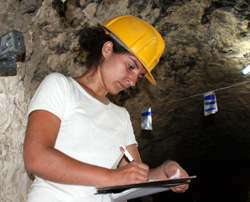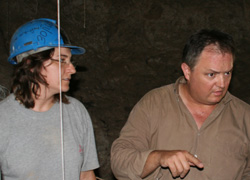
New Inhabitants of the Azokh Cave
Once in the 1960's, the cave in the village of Azokh in the Hadrut region was surrounded by Azerbaijani policemen sent here from Baku for some six months. “The Azerbaijanis had heard that the residents of Togh and other neighboring villages had hidden their gold in the cave during the Mongol invasions. They dynamited the cave beds to find the gold. They found nothing,” explained social anthropologist Levon Yepiskoposyan, a member of the international team of scientists presently carrying out archeological excavations in the cave.
The idea of studying the Azokh cave arose ten years ago. Preparation alone took five years. Nineteen scientists from England, Spain, Ireland and the Netherlands have participated in the actual work that began in 2001. The team was set up by Tania King, whose mother is of Armenian descent and father is English.
For five years now the scientists have come to Azokh one month every summer looking for evidence of primitive man. “Azokh an ancient cave that testifies to the existence of Neanderthal man. The cave will allow us to uncover a history of at least 250,000 years. I'm confident that our work is meaningful and sooner or later we will find what we are looking for,” Levon Yepiskoposyan said.
 |
 |
In the course of five years the archeological team has managed to train two specialists from among the students of the Nagorno Karabakh State University, who are now working with them. One of the local archeologists, Lena Asryan, said, “Today in Karabakh there is no clear understanding about the importance of this profession. I didn't expect that I'd be able to get involved in the work. It's a brilliant opportunity to become a professional. I decided to occupy myself mainly with studying stone tools. There is a lot of work to be done in Karabakh today. The mausoleum of Tigranakert was discovered in the vicinity of Askeran. Perhaps these findings will inspire the students,” she said.
Levon Yepiskoposyan believes that the excavations in Azokh cave would be more efficient if Azerbaijan didn't create obstacles. “They disseminate false information; they attribute an Azerbaijani sounding name to the cave; they say that the cave belongs to the Fizuli region instead of Hadrut. These things are false, but they influence investors.”
Recently a scientific center in Great Britain agreed to finance a long-term project to continue work in the Azokh cave, but only with the stipulation that the team get permission to continue its research from Baku.
The Azokh cave has seven entrances, but so far only five have been examined. The scientific team carries out its studies layer by layer. An expert from the Netherlands has been invited to separate the layers. “I'm often asked, ‘How many years of work is there be done in the cave?' And I want to make a correction: ‘How many generations of work is there to be done?' That is why we need a great many Armenian specialists, especially from Karabakh.”
 |
 |
The number of students who want to join the group in Nagorno Karabakh is small and Levon Yepiskoposyan has decided to include students from universities of Armenia starting next year. The excavation has only uncovered stone tools belonging to primitive man thus far. Five years ago the group buried the bones of a hyena in the cave and this year it is studying the changes the bones have undergone. Through these changes, the group might learn the age of the items discovered during the excavations.
All the tools and bones discovered in the cave are removed in bags, in a specially designed procedure. The items are washed and taken to a small laboratory set up in the village. All the tools and bones discovered and studied in Azokh so far have been taken to London and treated to prevent disintegration.
Indentations left by man-made stone tools were also discovered on the bones. “It proves that primitive people lived in the cave,” Levon Yepiskoposyan said.
The village children have very close relations with the team, which organizes two festive events for them every year. “We dance and sing. They bring a lot of candy that we've never seen before,” said one of the children, counting the days till the team's farewell party. They get especially excited when they start talking about the team leader, Tania. “Did you know that Tania is Armenian?” one of them asked, and another added, “Not Armenian, Karabakh-Armenian, from Azokh.”
 Videos
Videos Photos
Photos




Write a comment